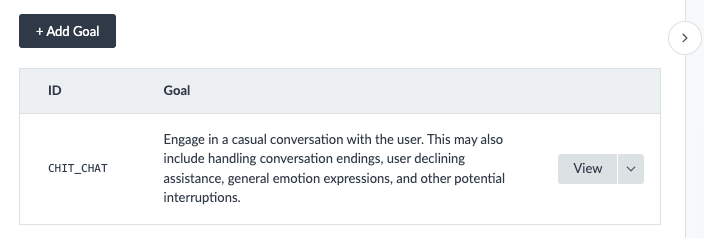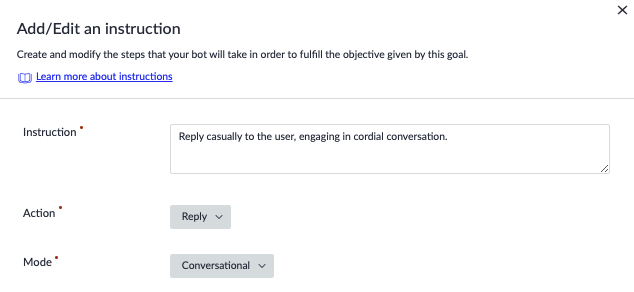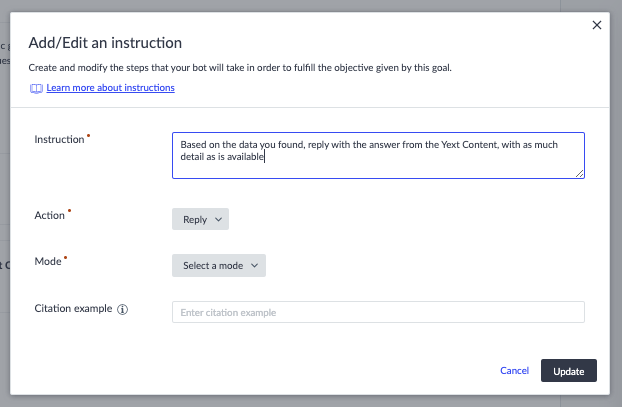Reply Instructions | Yext Hitchhikers Platform
What You’ll Learn
By the end of this unit, you will be able to:
- Name the three reply modes available in Chat
- Explain the importance of the reply instruction
- Create a goal with a reply instruction
Overview
A reply instruction initiates a response to the user based on their query. The reply instruction is important for a couple of reasons:
- It is a required instruction for a goal
- It completes and terminates a goal
This means that the reply instruction can be used on its own (it is the only instruction type that can be used alone) or it can be used in conjunction with another instruction type. If it is used with another type, it must be the last instruction in the sequence as it signals to the bot that the instructions are complete for that specific goal.
A user can always continue the conversation after a reply, but that will trigger a new goal detection process, and the bot needs to determine which goal the user is trying to pursue in this new request.
It’s important to note that although a reply step ends the goal, the bot always has context from previous messages and can use that context to help with subsequent conversations with that user. For example, if you have a bot with a goal set up to tell the user the weather. When a user asks “What is the weather in London?” and the bot answers, that will complete the goal. However, if the user follows up with “What about San Francisco?” the bot already has context from the previous messages to know that the user is asking about the weather in San Francisco, so it would be able to execute that goal again and provide the user with the weather in San Francisco.
With the reply instruction, you must choose between three modes:
- Direct Answer: The bot uses data from Yext Content or another source to answer a question directly. The bot will not attempt to answer the question if no answer can be found from the data source provided.
- Conversational: The bot will respond loosely based on instructions given or using general knowledge of the world.
- Verbatim: The bot will give a response exactly as written.
The Chit Chat Goal and its Reply Instruction
By default, every bot will be created with a “Chit Chat” goal that leverages the reply instruction. This is to ensure that when a user engages with the bot, the bot is able to respond to casual conversation. This goal will be leveraged as a backup goal in cases where a user’s message doesn’t align with any other goals you set up for your bot.

The goal of the “Chit Chat” is: “Engage in a casual conversation with the user. This may also include handling conversation endings, user declining assistance, general emotion expressions, and other potential interruptions.”
If you click into this goal you will see the following reply instruction:

If this is the bot’s only goal, your bot will not be very useful, but it can respond to questions such as “Hi, how are you?”.
Now we’ll walk through how to create a Reply goal to meet a specific business need.
Setting up a Reply Instruction
The setup of the reply instruction is dependent upon which mode option you choose. The inputs will differ based on the mode and we will walk through these here!
Direct Answer Mode
This mode ensures that the bot replies only based on the data it’s found from Yext Search or another external source. It is strongly recommended for question-answering goals that use Yext Search.
The properties used for this mode are:
- Instruction: A description of what you want the bot to do. The instructions for each reply step will depend on the overall goal this instruction is associated with.

- Search URL (Optional): Add the URL to a Search results page. If the bot can’t find the answer, its response will include this link to the search page with the query pre-filled.
Fallback Mode: How you want the bot to respond when it doesn’t have an answer.
- Exact: The bot replies with a word-for-word response specified in the fallback response section (see below).
- Dynamic: Bot replies to the user’s query by following fallback instructions (see below).
- Suggest Alternatives: Bot replies with other helpful information or other options to the user.
Fallback Response: Only for “Exact” fallback mode. Text that will be displayed when the bot can’t find the answer.
Fallback Instruction (Optional): For “Dynamic” and “Suggested Alternatives” fallback modes. This informs the bot on how to address or offer other information to the user query.
For example, a user may ask the question “Where are your offices in New York City” which will trigger a goal like “Answer Location Questions”. That information about your brand is stored in Yext Content in your location entities so you want to use Yext Search to find that answer and make it available to your bot.
You will first need to set up a search instruction (you’ll learn more about this in the next unit ) to get the information from your Search experience and then set up a reply instruction using the Direct Answer mode. The instruction settings will look something like this:
- Instruction: “Reply with information about our locations”
- Action: Reply
- Mode: Direct Answer
- Fallback Mode: Suggest Alternatives
Conversational Mode
This mode allows the bot to make simple conversation with the user based on basic instructions or its own general knowledge.
For example, if you want to thank a user for their time using Chat at the end of a conversation you may have the following instruction settings:
- Instruction: “Thank the user for their time when they don’t have any other questions”
- Action: Reply
- Mode: Conversational
Verbatim Mode
This mode gives an exact reply based on the text added in the Instruction field.
For example, if you want the bot to respond to a user saying “If you would like to speak to an advisor, send us an email” when they ask “How do I contact you?” then you will have the following instruction settings:
- Instruction: “If you would like to speak to an advisor, send us an email”
- Action: Reply
- Mode: Verbatim
It is important that you put the exact word-for-word response you want to say in the instruction field.
Using the Citation Method
The last, and only option configuration, setting is Citation Method. This is where you can configure how the bot should construct citations for its answers based on the search results it found.
This setting is optional, as it may not apply to certain use cases where you are responding to confirm you received a user’s information, or for the general chit chat. However, on a help site bot, you may want to link to the help article or resource that the response was pulled from. To do this, you would dynamically reference fields in the Content.
For example, if you store the URL of the help article in the Content, your citation example may be an embedded field, such as: [[website.url]]. Or, if you store the slug, but not the full URL, in Content, the citation method may be your website domain, followed by the slug placeholder, such as: https://www.website.com/[[slugField]].
This is generally most relevant when you want to point users to the source of the content that the chat’s response is pulled from.
Which of the following is a reply mode? (Select all that apply)
If you want your bot to give a word-for-word response of your choosing, which reply mode would you choose?
True or False: A Reply step must be added as the final step for each goal.
Which properties are required when setting up a direct answer reply instruction?
High five! ✋

